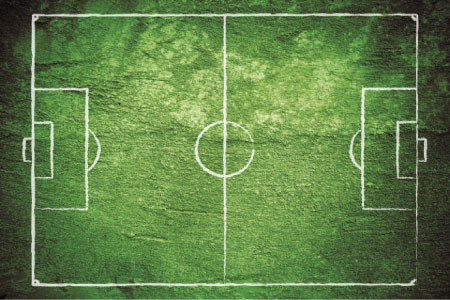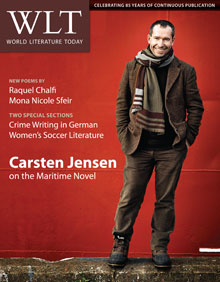Introduction: World Cup/World Lit 2011
Do I love you precious moments?
Reply, for life is slowly killing me.
Do I love you precious moments? Yes or no?
—Clarice Lispector, Jornal do Brasil, 20 September 1969

The cherishing of moments, within literature and popular media, is an ongoing struggle for women in sport. Clarice Lispector wrote ten years before Brazil lifted a nationwide ban on soccer for women, more than twenty years before those in charge of association football mustered the institutional will to stage a Women's World Cup. The finals of the sixth Women's World Cup will play out in Germany from June 26 to July 17, prompting WLT's look at soccer through the eyes of women writers, artists, and dogged female competitors: Nalinaksha Bhattacharya (India), Mona Nicole Sfeir (US), Ana María Moix and Yrsa Roca Fannberg (Spain), Elísabet Jökulsdóttir (Iceland), and Clarice Lispector (Brazil).
Like Edna Pontellier in Kate Chopin's The Awakening, women soccer players reach out in sport for the "unlimited" in which to lose themselves. The Women's World Cup includes sixteen teams and will expand to twenty-four in 2015. The spread of women's soccer to new horizons is evidenced by the presence for the first time of Colombia and Equatorial Guinea in the final phase.
Although advocates for and organizers of women's football existed in England and Scotland in the late 1800s, one of the top English-language historians of the sport, Jean Williams, describes the sport's culture in terms of rootlessness. To unearth the particulars of players and organizations that supported them in industrial Britain and the United States, Williams carried a portable scanner to informants' homes in order to catalog pictures and ephemera of no interest to museums. Soccer for women is an idea tantalizing in practice, but weak in word and memory.
As the writers in this section testify, women of diverse cultures and times have defined themselves in relation to men's football, such as women in Iran who, for more than a decade, have harnessed euphoria surrounding the national team to question Islamic restrictions on dress and women's attendance at football stadiums. Women in soccer are an implicit and often explicit threat in both tradition-bound and liberal societies. During a postseason press conference in fall 2010, Anne-Marie Eileraas, chief executive of Women's Professional Soccer, the seven-team league in the United States, claimed there is no discrimination facing professional women's sports. But her dismissal of prejudice ignores reality and the shocking lack of media attention for women athletes, even in the West. The percentage of sports coverage given to women has declined sharply over the past twenty years, according to the Center for Feminist Research at the University of Southern California. Men's sports in 2009 received 96.3 percent of airtime in the United States, women's sports 1.6 percent.
Within this section, Catalan writer Ana María Moix approaches the sport through FC Barcelona, one of the most famous men's teams in the world. Reykjavík poet Elísabet Jökulsdóttir connected to soccer through her sons. For Jökulsdóttir, the essence of world football is communication, an insight that followed a communications breakdown in her family. Jökulsdóttir's sons view her tendency to mix life and soccer as heresy, but she persists with a vision of sport that encompasses the unfathomable.
Women help revitalize a sporting universe of tedium—the routine of "one damn game after another"—by reaffirming soccer's connection to life. Football is more than football, Lispector tells the gifted soccer columnist, her contemporary Armando Nogueira. She affirms Nogueira's capacity to write about football, but what about life? In her separation from futebol, Lispector feels cut off from Brazil ("dispirited by my smallness")—an exile from conversation and experience also identified by Moix and Jennifer Doyle, who writes about the striking soccer paintings of Yrsa Roca Fannberg, a lifelong Barça fan. By introducing readers in the early 1990s to Hemprova Mitra, Bengali writer Nalinaksha Bhattacharya showed how a female athlete, by petitioning for a right to play soccer and by building school and amateur teams, could confront a domesticated life of fulfilling male expectations. Moreover, Hem's football is not genteel. Her face is scarred, her play violent.
Colombian anthropologist Beatriz Vélez describes soccer as a game of antagonisms, beginning with the idea of propelling a ball without the hands. Women players add another opposition. Their participation disturbs a system of interpretation geared toward affirming masculine identity. For practitioners such as the Chosen Few Lesbian Soccer Club in Johannesburg, football is freedom, playing a public display of joy. Such players live "out" in an often homophobic society that sells the illusion Brazilian educator Paulo Freire felt was widespread in human community—"to be is to be like."
Throughout the world, the laws of soccer are fundamentally controlled by males—specifically, eight white men who compose the International Football Association Board and who judge, in secret, on rules affecting women and men. The laws are hallowed. The 1863 laws of association football were featured, alongside the Magna Carta and Isaac Newton's Principia Mathematica, in a recent British television series, Twelve Books That Changed the World. In this section, poet and artist Mona Nicole Sfeir examines what might be called the shadow side of the male laws.
Edna Pontellier challenged domestication by swimming. Chopin's character learned through an act of physical rebellion to inhabit her body, perhaps for the first time, and to claim experience that should have been hers all along.
It is not uncommon for women to enforce gender norms on themselves and each other, a phenomenon confirmed in the story of the world's most transcendent female soccer player, Marta Vieira da Silva of Dois Riachos, Brazil. "I insisted that Marta not dream anymore about being a soccer player, because that was never going to happen," Tereza Vieira de Sá, Marta's mother, told journalist Diego Graciano. "In addition to this, she would probably get seriously injured." To which Marta replied, "If I die of injuries from playing soccer, I want you to place a soccer ball inside my coffin, so that I will die satisfied."
Atlanta, Georgia
Author note: I thank all contributors, translators, Yrsa Roca Fannberg, and the Riyas Komu studio in Mumbai. I thank Gisele Mendonça do Nascimento for consultation on Portuguese, Julie Gaucher for leads to writing in French, and Frank Fury for insight into Kate Chopin at the Sport Literature Association conference in June 2010. The section is dedicated in memory of Rev. Buddy Hughes, who shared an elevator with Pelé and, for love of soccer and literature, translated from Portuguese portions of the only existing biography of Marta Vieira da Silva.

